
Over the past year, LinkedIn for higher education has arguably been the most difficult social media platform for student recruitment professionals to navigate, as a rethink of the company’s positioning in the student market and wholesale changes to the features provided for educational institutions has brought uncertainty and confusion.
The first major shift occurred last May, when the site scaled back a number of its existing university search features, while September brought more changes, as the company announced that it was merging its old university pages with its company pages, providing schools with a singular LinkedIn presence. The site began gradually rolling out the new-look pages in late December.
Although a few features have been sacrificed, the revamped design has received a mostly positive reception, with a number of improvements that make could make LinkedIn an even better tool for generating more inquiries from prospective students. If you ever need help with social media marketing for educational institutions with these constant updates, then contact our team for assistance.
What Do LinkedIn’s New University Pages Look Like?
Essentially, the new LinkedIn University Pages aim to provide a hybrid of the most popular features of the old design and your existing company page. This means that while they still include content designed for prospective, current, and past students, the page is also used to manage your presence as an employer on the site.
Example: A snapshot of the University of Illinois at Urbana-Champaign’s new university page. As you can see, the school’s profile now displays both information for students and new job postings.
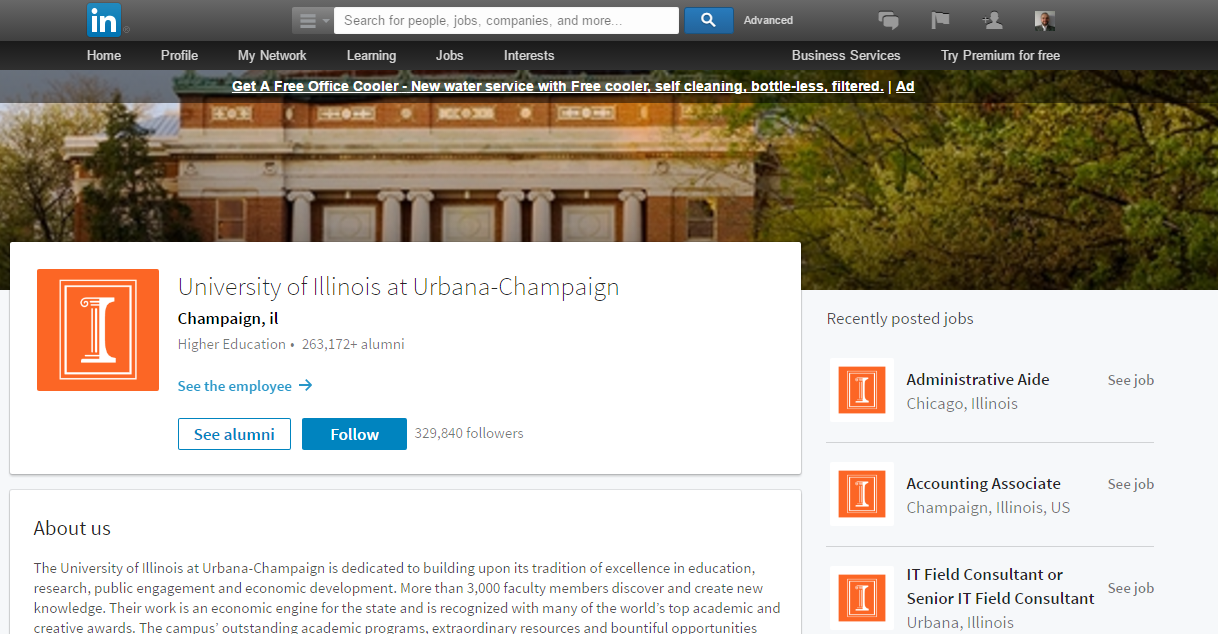
This amalgamation should make your LinkedIn presence much easier to manage, allowing you to centralize all of your administration using a single account.
The merger has also ironed out some of the inconsistencies of the previous system. For instance, LinkedIn Showcase Pages, a feature which allows organizations to create customized individual pages within the site, has become a popular way for schools to promote specific programs and departments, but was not available on the previous university pages. This led to many institutions creating the pages through their company page, which limited their chances of being found by actual prospective students. The new design rectifies this, making it easier to use the feature to its full potential.
Example: This Showcase Page for the University of Michigan’s College of Literature, Science and the Arts allows the school to promote the department more effectively on LinkedIn, giving it a dedicated space and content tailored specifically for its audience.
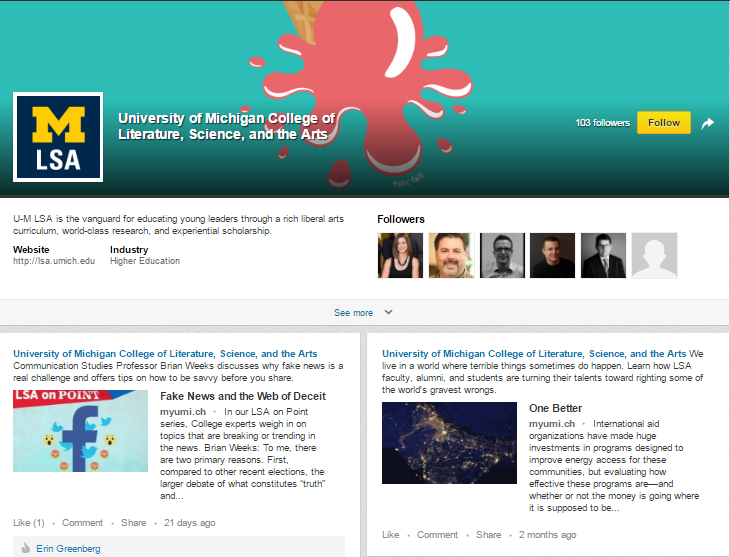
Because the university page design supports Showcase Pages, prospective students can now access this content more directly, increasing your chances of reaching seriously interested leads, who may have missed the page if it were still hidden on your company profile.
Another feature schools can now access is Sponsored Content through LinkedIn ads for schools. The valuable native advertising feature, which allows you pay to make your posts visible among strategically defined audiences, could open up a range of new possibilities for schools, allowing you to target content towards prospective leads in specific locations, industries, and even companies.
This opens up exciting possibilities for schools who produce high quality, informative content marketing, allowing them amplify the reach of their posts and increase engagement. The tool could be particularly beneficial to schools offering postgraduate and professional development programs, as they can target their campaigns specifically at professionals in their field.
Example: This post from WU Executive Academy, which promotes its MBA in Energy Management program, would be ideal for Sponsored Content campaigns. It’s industry-specific and informative, and tailored for an audience who is likely have a large and active presence on the site.

The feature also includes a useful Direct Sponsored Content option, which allows you to create sponsored posts exclusively for your audience’s feeds, without publishing them on your own page. This can be extremely useful if your school is looking to produce more personalized, targeted content that wouldn’t be suitable for your wider audience. It also offers unique opportunities for a/b testing your posts to gauge their engagement potential.
Disadvantages of the New Design for LinkedIn for Higher Education
Unfortunately, creating a shared space for all of the functions on both University and Company Pages has meant that LinkedIn for higher education has needed to jettison some features. The new University Page will feature a version of the old page’s alumni tool, which displays the location and employment destinations of your graduates, as well as selected profiles.
Example: The new Alumni Page of The University of Manchester.
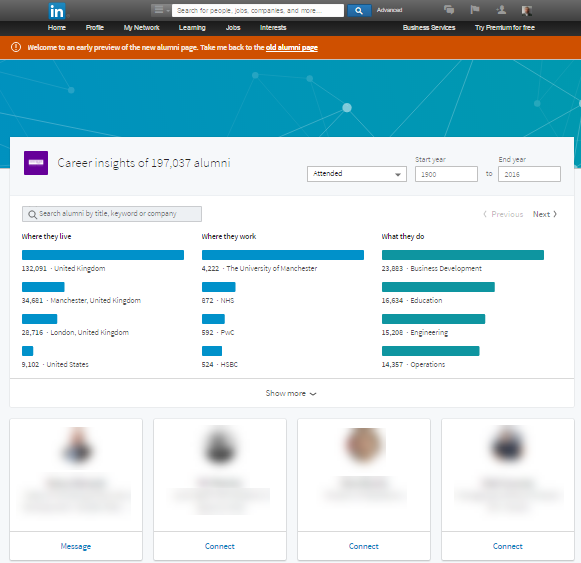
However, two prominent features of the previous alumni page have now been discontinued. The first is the Notable Alumni section, which promoted profiles of graduates in high ranking professional positions, giving prospective students a glimpse of the kind of success that could await them if they pursued an education at your school.
Example: An old snapshot of the University of Phoenix’s University Page with the discontinued Notable Alumni feature highlighted. Note how Notable Alumni profiles were displayed on the side of the University Page, meaning new leads were presented with them immediately.
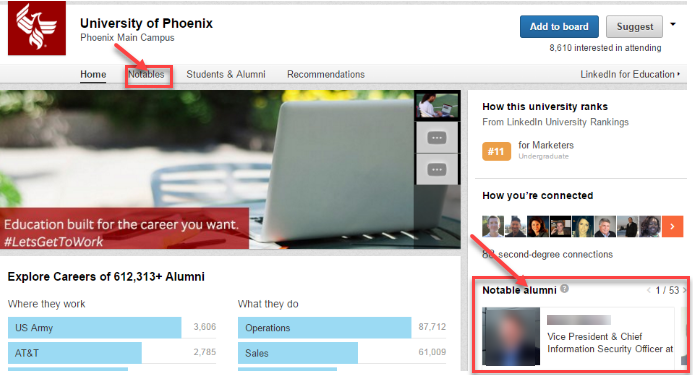
The other major feature that will no longer be available is Alumni Recommendations, which allowed graduates to post about their experiences at your school. This was a great source of user generated content and regularly provided excellent student testimonials for many schools.
Example: An old screenshot of an alumni recommendation from South New Hampshire University.

Coupled with LinkedIn’s previous retooling of its higher education features, which rolled back the site’s University Finder, Field of Study Explorer, Decision Boards, and University Rankings, the discontinuation of these features do mean that schools now have far less avenues for reaching students on the site than in recent years.
Nonetheless, a more stripped down and streamlined interface may not be a bad thing, making managing your LinkedIn presence much simpler and allowing administrators to concentrate on the features that drive the most engagement on the site.
University Pages Will Include Enhanced Analytics for Student Recruitment
A chief complaint of many student recruitment professionals about LinkedIn’s previous University Pages service was the limited analytics offered compared to Company Pages. The previous interface provided very little data about followers, post clicks or page impressions, meaning promoting your school on the site required large amounts of guesswork.
Company Pages on the other hand, included a comprehensive analytics dashboard filled with actionable information. While analytics for the new University Pages are still in the process of being implemented, they will contain all the features that were previously available on your company page. Some of the data you can look forward to having on LinkedIn for higher education includes:
Updates– a comprehensive dashboard detailing the impressions, clicks, interactions and engagement for each individual LinkedIn post

Comprehensive Reach and Engagement data, detailing both overall and unique page impressions, and providing an overview of clicks, engagement percentages, likes, comments, shares, and followers acquired over a set period of time.
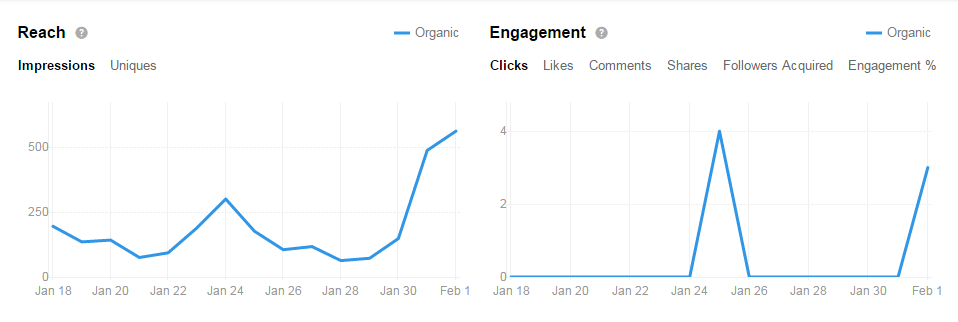 Follower demographics- This is an extremely useful feature which allows you to view unique demographic information about your followers. LinkedIn’s professional focus means this tool offers insights you won’t get anywhere else, as you can view followers by industry, company size, function, and seniority.
Follower demographics- This is an extremely useful feature which allows you to view unique demographic information about your followers. LinkedIn’s professional focus means this tool offers insights you won’t get anywhere else, as you can view followers by industry, company size, function, and seniority.
You also get a clear view of which followers you have attracted organically and which were acquired through paid advertising, allowing you to assess the effectiveness of both avenues for increasing your visibility on LinkedIn for higher education. This makes LinkedIn university recruiting much easier overall.

Visitors- An additional dashboard allowing you to track recent visits to your site, as well as additional demographic information similar to that provided in the followers section.
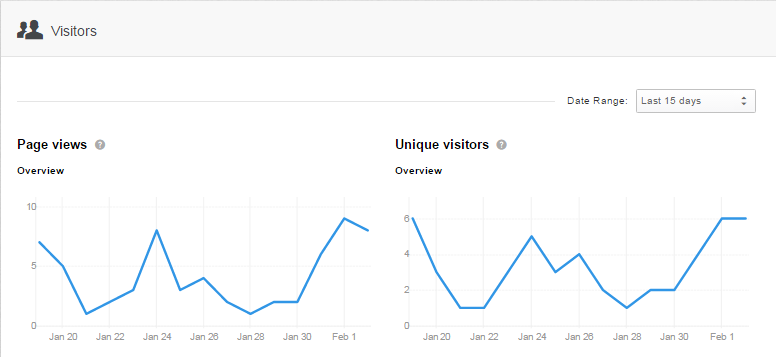
Finally being able to access proper analytics for student recruitment on University Pages is a great boost for schools, providing far more actionable insights which can help you produce more targeted and focused LinkedIn campaigns and measure your ROI from your initiatives on the site more effectively.
Other New LinkedIn Features To Boost Your Higher Ed Social Media Marketing Campaigns
University Pages aren’t the only part of LinkedIn’s service to receive a bit of a revamp this year. The company has been working hard to ensure that its paid advertising service Campaign Manager keeps pace with top competitors like Facebook and Twitter, and two recently announced changes in particular could mean big things for your higher education social media marketing campaigns.
The first, and perhaps most important, is the addition of a native conversion tracking tool which allows you to insert a LinkedIn Insight Tag on your website or landing pages to track specific conversion actions, such as filling out a form or downloading a specific content offer.
This development finally brings LinkedIn into line with other major social media advertising platforms, making it far easier to measure the cost-per-lead and overall ROI of your campaigns. It’s a fairly comprehensive service too, providing users with seven different conversion metrics for their campaigns, including cost per conversion , return on ad spend, and separate post click and view-through conversion rates.
Not only that, but the conversion data can be cross-referenced with LinkedIn’s unique user data, giving you access to detailed professional information about your leads, such as their job title, level of seniority, specific company, and more. This kind of data is unique to LinkedIn for higher education, and could help schools to add an entirely new level of personalization to their follow-up processes.
Another notable recent addition to Campaign Manager is LinkedIn’s Sponsored InMail, which was finally made available to all marketers in November. Previously, the service had required a minimum budget of US$25,000 in overall LinkedIn marketing spend, as well as US$5,000 for each InMail. These constraints placed the service outside the capabilities of most universities and other higher ed institutions, as well as limiting the overall flexibility of the service.
Now that it’s available in Campaign Manager, however, recruiters are free to tailor InMail campaigns to their needs, with no minimum spend commitments, allowing them to produce smaller, more personalized campaigns targeted at unique market segments.
This makes the service immediately more appealing to schools, allowing them to create multiple mails for different programs, target niche markets and regions, and run campaigns on a more realistic budget. It also makes it possible to perform small-scale A/B testing on your InMail campaigns before rolling them out, so you can tweak your content to maximize its conversion potential.
Combining the directness and personalization of email marketing with the reach and targeting capabilities of paid advertising, Sponsored InMail is a unique proposition, and one which could present a whole new world of possibilities for schools.
Campaigns can be created using the same criteria as other sponsored LinkedIn initiatives, allowing you to reach new leads in a more direct way. InMail content can also include personalized elements and CTAS, and are delivered in real-time only while a member is active on LinkedIn, with frequency caps to ensure your messages get the attention they deserve.
Check out this video to get a clearer picture of what Sponsored InMail can offer:

While there is great potential in Sponsored InMail, creating direct mail campaigns targeted towards brand new leads is unfamiliar terrain for schools, and care should be taken to ensure your content hits the right note. While it may be an option to repurpose some of your existing email campaigns, keep in mind that the leads you are targeting through InMail may not have specifically opted in to receive messages from your school, and you may need to refine your approach.
Unless you are remarketing to dropped applicants, these prospects will very much be at the ‘awareness’ stage of the enrollment journey, and need to be enticed to take further action with content that offers real value. Invitations to online events such as webinars, links to relevant blog posts, or downloads of supporting material such as brochures or prospectuses might be good examples of offers that will encourage further engagement.
Example: A featured case study on the site, Utah State University used a combination of display ads and Sponsored InMail to boost inquires for their MBA programs through LinkedIn, using the site’s professional user base to specifically target professionals in their region with less than five years of work experience. The school’s Sponsored InMail content enjoyed an extremely healthy 27.5% open rate.

Revitalizing Your LinkedIn for Higher Education Student Recruitment Strategy
Overall, the recent changes LinkedIn for higher education has undergone should be viewed as a positive for schools. The social media giant’s previous moves to divest from the college decision-making process left many in the industry questioning whether the site could still be a viable online student recruitment channel. The new design is well-thought out and offers many advantages, demonstrating that LinkedIn still cares about the needs of education marketers and has a vision of where they fit in its overall ecosystem.
Crucially, the changes are also set to be permanent, ending almost a year of uncertainty for schools and allowing them to begin to make a long-term plan for their LinkedIn campaigns without having to worry about which features they will still have access to.
And with improved analytics allowing you to measure the impact of your marketing efforts on the site more accurately going forward, your school could soon be getting more out of your LinkedIn campaigns than ever before.
What do you think of your new LinkedIn University Page? Leave a comment below and tell us about your experiences!






